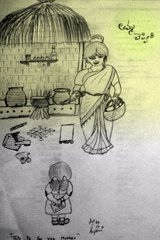Thanks Samina! yet again for your lovely dish. This one is excellent and became my family favorite. Check out the other recipe I tried from her Channa pulao with Spinach. for vegetarian version.
Good for picnic or for unexpected guests or just treat your self :-)
Ingredients:
1) For Curry:
Diced Lamb - 1/2 kg (read tips)
Cut these into small pieces, but bigger than minced (in other words moti keema). Wash well, keep these in cooker bowl add 1/2 tsp salt and required water. Pressure cook for 20 mins. When the pressure is down, drain the liquid out while adding to the curry.
Onions - 2 large (slice thinly)
Oil - 1/2 cup
Ginger Garlic Paste - 1 tbsp
Coriander Powder - 2 tsp
Red Chilli powder - 2 tsp
Cayenne Pepper - 1/2 tsp
Salt to taste
Whole Tomato - 3 large (chopped)
Water - 1/2 cup
For Garnish:
Curry leaves - 2 sprigs (cut them with scissors or finely chopped)
Coriander leaves - handful (chopped finely)
Mint leaves - handful (chopped finely)
Proceed for Curry:
1) Now heat a flat deep nonstick pan, add oil once heated fry the onions in batches until golden color (reserve the first batch for layer).
2) Add gg paste, fry for few mins.
3) Add strained keema to it, fry for 3 mins.
4) Add all powders and fry.
5) Add tomato pieces, cook until mushy.
6) Add water and cook until all the water has evaporated by keeping the lid on. Switch off and keep it covered for 5 mins.
7) To this, garnish with above ingredients.
2) For Rice:
Basmati Rice - 1/2 kg or 2 cups
Water - 4 cups
Whole Garam Masala - { 1 tsp Shahjeera, Whole Cloves - 8 no., Cardamom - 8 no., Black Pepper - 10 no., Bay leaf - 5 no., Cinnamon stick - 1 inch}
Salt - 3 tsp
Green Chillies - 4 no. (remove the stem and slit lengthways, with out tearing apart)
Proceed for Par-boiled Rice:
Bring water to boil in a deep dish, along with all other ingredients, except rice. Once it comes to boiling point add washed basmati rice to it, cover and reduce it to simmer until rice is cooked 3/4 th (we do dum, so cook only 75 %). Once finished, drain the water out in stainer completely (me does in Jalleda, once the rice drained out, I keep the stainer in an angle, this way the water comes out very easily) spread out in flat dish or pallem. Remove the chilli bit and add it to garnish curry.
3) For layering:
Colored Yoghurt - 125 g Yoghurt + Yellow Food Color - 1/2 tsp (mix this well)
Mace Nutmeg Powder - 1/2 tsp + 1/2 tsp extra
Colored Milk - 1/4 tsp yellow color + little milk (mix these both)
Lemon - 1 no. (take juice)
Proceed for final touch:
1) Grease the deep flat dish with butter all around.
2) Add half the cooked rice.
3) Add another layer of entire curry.
4) Add reserved fried onion on top.
5) Add all the colored Yoghurt.
6) Add 1/2 tsp of mace nutmeg powder.
7) Add all the lemon juice.
8) Add the remaining rice on top.
9) Add remaining 1/2 tsp mace nutmeg powder on top.
10) Top it up colored milk on top.
11) Keep the lid on tightly, and do dum on simmer heat for atleast 30 - 35 mins.
12) Once finished mix it lightly all through and serve.
Serve with Kachumber or Raita.
Tips:
Meat = we need smaller pieces but not too fine, so that they are firm to bite.
I buy Nutmeg Powder in packets, no need to grate. It is quite easy.
Meanings:
Mace = Javithri
Nutmeg = Jaiphal = Jajjikaya (in Telugu)
© 2009 by Rajani Rayudu


![]()


![]()


![]()

![]()

![]()

![]()

![]()



![]()


![]()
![]()


![]()

![]()

![]()

![]()
![]()
